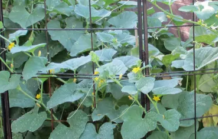We occasionally receive calls from gardeners who want to know how to treat an apple seed so it will germinate. Usually, the gardener is trying to reproduce an old apple tree that was special for some reason (good quality fruit, planted by grandparents, etc.). Unfortunately, apples grown from seed will not be like the parent. About 1 in every
80,000 apple trees grown from seed will be as good as the apples we are used to eating. Apple trees grown from seed usually have small and inferior quality fruit.
If you want a tree exactly like the parent, you must propagate that tree vegetatively. In the case of apples, this usually means grafting.
Apple trees are actually quite easy to graft, even for novices. Don’t be afraid to try even if you haven’t grafted before. The step that needs to be done at this time of year is the choosing and cutting of scion wood or small branches that will be grafted on top of a rootstock.
See the accompanying article in this newsletter on how this is done. However, if you don’t have an existing tree to graft onto, you will need to plant a rootstock this year for grafting onto next. Fruit trees are normally grafted (or budded) onto specially selected rootstocks. These rootstocks usually reduce tree size. For example, a tree that normally would reach 25 feet tall will only reach 10 feet if it is grown on a certain rootstock. Dwarfing rootstocks also allow apples to bear fruit a year or more earlier.
A tree on its own roots normally takes 5 to 7 years before it will bear. Semi-dwarf trees bear in 4 to 5 years, and dwarf trees bear in 3 to 4 years. Unfortunately, not all dwarfing rootstocks are well adapted to Kansas. Semi-dwarf trees usually are a better choice for us. Note that rootstock reduces tree size, not fruit size. Therefore, a Golden Delicious tree that only reaches 8 feet tall due to a dwarfing rootstock, will bear the same size fruit as a Golden Delicious tree that is 25 feet tall.
Most nurseries only sell trees that are already grafted. A company that does sell rootstocks is Raintree Nursery, Morton, WA, (360) 496-6400, http://www.raintreenursery.com/Rootstocks/
Another is Cummins Nursery, (865) 233-3539, http://www.cumminsnursery.com/rootstocks.htm though there is a minimum shipping and handling fee of $20.
It is also possible to buy a tree from a local nursery and graft your clone into it. This will give you one tree that produces two different apples. One disadvantage of this method is that it is possible to prune off the special clone by mistake in later years.
This information does not include the details of grafting or budding or subsequent care. The Missouri Extension Service has an excellent publication on grafting at
http://extension.missouri.edu/explorepdf/agguides/hort/g06971.pdf as
well as a second publication on budding at http://extension.missouri.edu/explorepdf/agguides/hort/g06972.pdf .
Be sure to practice your cuts on wood you prune off in March. After you do about 100 cuts, you will start to get the hang of it. (Ward Upham)




